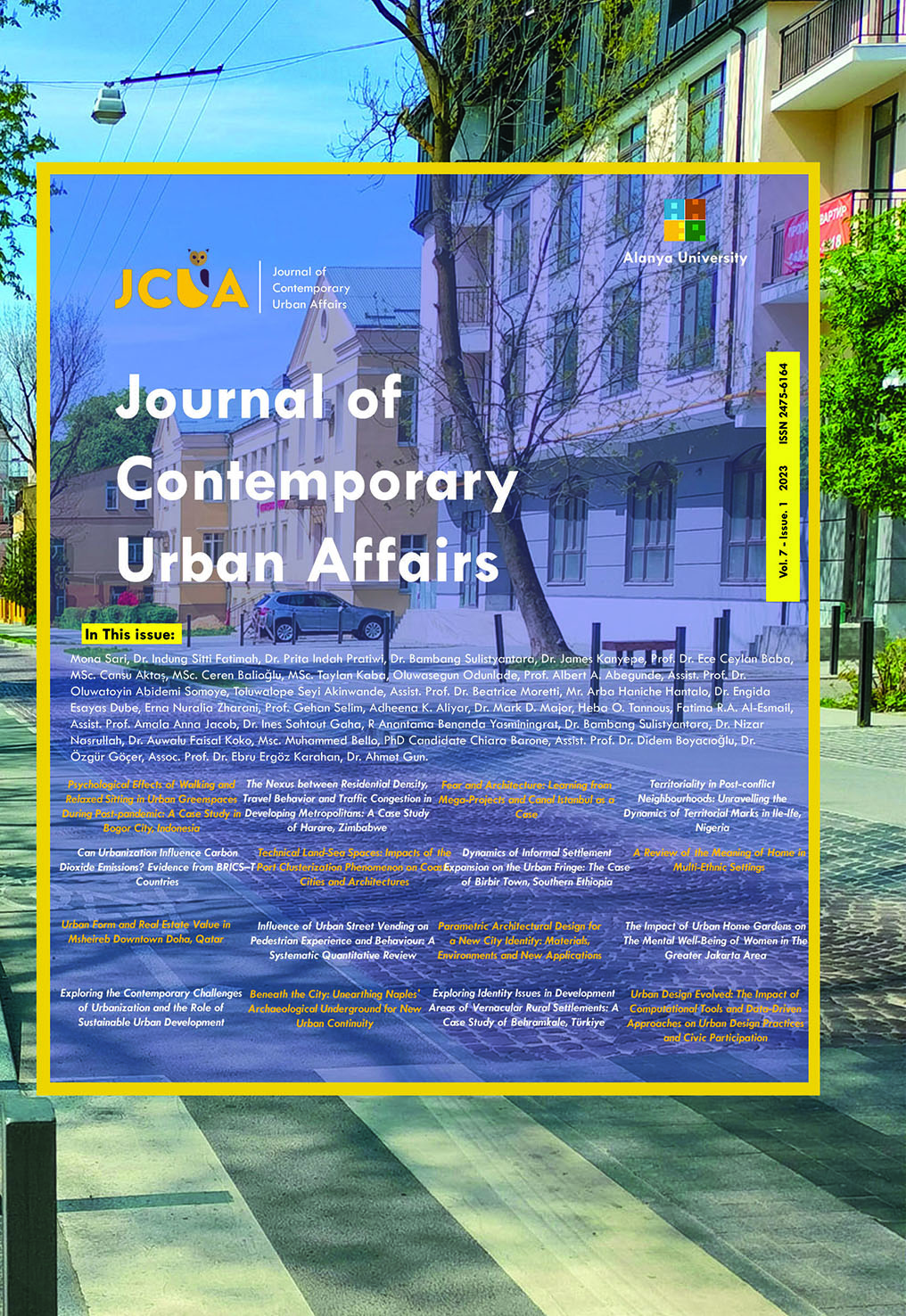A Review of the Meaning of Home in Multi-Ethnic Settings
DOI:
https://doi.org/10.25034/ijcua.2023.v7n1-8Keywords:
Meaning of Home, Multi-Ethnic, Home Practice, Home Making, Physical HomeAbstract
This paper explores the meaning of home from multiple regions and the factors that influence the definition of home from multi-ethnic perspectives. A hypothesis derived that each ethnicity of a household practises cultural values and that reconfiguring physical spaces provides greater knowledge of their definition of home. This study employed a systematic review to gather the most relevant papers in the existing literature from the year 2000 to 2023, to address the gaps in knowledge in conceptualising the meaning of home in multi-ethnic settings. The findings respond to the hypothesis of this paper, that each household practises privacy and social boundaries in line with their belief systems and that reconfiguring physical space is part of homemaking tactics. This study outcome contributes to the development of a new conceptual framework that clarifies a comprehensive cause-effect relationship between key variables, ethnicity as the social aspect, built space as the physical aspect and practice as the personal or psychological aspect, resulting in a greater understanding of the meaning of home in multi-ethnic settings from three scenarios; the home as socio-spatial, psycho-spatial and emotive space entity.
Downloads
References
Abdelmonem, M. G. (2012). Responsive homes of old Cairo: Learning from the past, feeding in the future. Hospitality and Society, 2(3), 251–271. https://doi.org/10.1386/hosp.2.3.251_1
Abdelmonem, M. G., & Selim, G. (2012). Architecture, memory and historical continuity in Old Cairo. Journal of Architecture, 17(2), 163–189. https://doi.org/10.1080/13602365.2012.678634
Abdullah, W. A. M. W., Roslan, N. H., Ismail, S. A., Mansoor, M., & Elyssa, N. (2022). Multi-ethnic harmony in diversity country with functionalism theory in Malaysia. Baltic Journal of Law and Politics: A Journal of Vytautas Magnus University, 15(3), 493–511. https://doi.org/10.2478/bjlp-2022-002037
Abed, A., Obeidat, B., & Gharaibeh, I. (2022). The impact of socio-cultural factors on the transformation of house layout: a case of public housing - Zebdeh-Farkouh, in Jordan. Journal of Asian Architecture and Building Engineering, 00(00), 1–14. https://doi.org/10.1080/13467581.2022.2074021
Abu-Ghazzeh, T. M. (2000). Environmental messages in multiple-family housing: Territory and personalization. Landscape Research, 25(1), 97–115. https://doi.org/10.1080/014263900113190
Abu Bakar, A., Malek, N. A., Mohit, M. A., Othman, R., Nur, A., & Sanusi, Z. (2016). Housing Space Quality towards Quality Of Life: A Case Study of Double Storey Terrace Houses. MATEC Web of Conferences 66, IBCC, 1–10. https://doi.org/10.1051/matecconf/20166600083
Al-Mohannadi, A., Major, M. D., Furlan, R., Al-Matwi, R. S., & Isaifan, R. J. (2023). Investigation of Spatial and Cultural Features in Contemporary Qatari Housing. Urban Science, 7(2), 60. https://doi.org/10.3390/urbansci7020060
Al-Tarazi, D. (2021). “What makes a house a home?”: A theoretical model for the architectural design of homes based on human psychological needs to support and promote users’ psychological well-being (Issue February) [University of the West of England]. https://uwe-repository.worktribe.com/output/6112388
Al-Thahab, A. A. L. (2016). Towards Sustainable Architecture And Urban Form : Socio-Cultural Aspects of Sustainable Application of the Practice of Home and the Mahalla"s Everyday Life in Iraq [University of Wolverhampton]. http://hdl.handle.net/2436/621928
Aromataris, E., & Pearson, A. (2014). The systematic review: An overview. American Journal of Nursing, 114(3), 53–58. https://doi.org/10.1097/01.NAJ.0000444496.24228.2c
Aziz, A. A., & Ahmad, A. S. (2012). Home Making in Low-Cost Housing Area. Procedia - Social and Behavioral Sciences, 49, 268–281. https://doi.org/10.1016/j.sbspro.2012.07.025
Boccagni, P., & Kusenbach, M. (2020). For a comparative sociology of home: Relationships, cultures, structures. Current Sociology, 68(5), 595–606. https://doi.org/10.1177/0011392120927776
Bourdieu, P. (1977). Outline of A Theory of Practice (R. Nice, Trans.). In E. Gellner, J. Goody, S. Gudeman, M. Herzfeld, & J. Parry (Eds.), Cambridge Studies in Social and Cultural Anthropology. Cambridge University Press. https://doi.org/https://doi.org/10.1017/CBO9780511812507
Case, D. (1996). Contributions Of Journeys Away To The Definition Of Home: An Empirical Study Of A Dialectical Process. Journal of Environmental Psychology, 16, 1–15. https://doi.org/https://doi.org/10.1006/jevp.1996.0001
Certeau, M. de. (1984). “Making do”: Uses and Tactics (S. Rendell, Trans.). In The Practice of Everyday Life (pp. 1–254). University of California Press. https://monoskop.org/images/2/2a/De_Certeau_Michel_The_Practice_of_Everyday_Life.pdf
Crowe, M., Inder, M., & Porter, R. (2015). Conducting qualitative research in mental health: Thematic and content analyses. Australian and New Zealand Journal of Psychiatry, 49(7), 616–623. https://doi.org/10.1177/0004867415582053
Cuerdo-Vilches, T., Navas-Martín, M. Á., & Oteiza, I. (2020). A mixed approach on resilience of spanish dwellings and households during covid-19 lockdown. Sustainability (Switzerland), 12(23), 1–24. https://doi.org/10.3390/su122310198
Easthope, H. (2004). A place called home. Housing, Theory and Society, 21(3), 128–138. https://doi.org/10.1080/14036090410021360
Graham, L. T., Gosling, S. D., & Travis, C. K. (2015). The Psychology of Home Environments: A Call for Research on Residential Space. Perspectives on Psychological Science, 10(3), 346–356. https://doi.org/10.1177/1745691615576761
Hamid, Z. A., Hung, F. C., & Beng, G. H. (2017). Affordable and Quality Housing Through Mechanization, Modernization and Mass Customisation. Modernisation, Mechanisation and Industrialisation of Concrete Structures, February, 452–474. https://doi.org/10.1002/9781118876503.ch11
Hamzah, H., & Adnan, N. (2016). The Meaning of Home and Its Implications on Alternative Tenures: A Malaysian Perspective. Housing, Theory and Society, 33(3), 305–323. https://doi.org/10.1080/14036096.2016.1143025
Hand, M., Shove, E., & Southerton, D. (2007). Home extensions in the United Kingdom: Space, time, and practice. Environment and Planning D: Society and Space, 25(4), 668–681. https://doi.org/10.1068/d413t
Handel, A. (2019). What’s in a home? Toward a critical theory of housing/dwelling. Environment and Planning C: Politics and Space, 37(6), 1045–1062. https://doi.org/10.1177/2399654418819104
Heidegger, M. (2001). Building Dwelling Thinking (A.Hofstadter, Trans.). In Poetry, Language, Thought (Vol. 46, Issue 4, p. 670). Harper & Row . (Original work published in 1971). https://doi.org/10.2307/40126613
Hu, X. (2008). Boundaries and openings: Spatial strategies in the Chinese dwelling. Journal of Housing and the Built Environment, 23(4), 353–366. https://doi.org/10.1007/s10901-008-9123-z
Im, L. P., & Fah, C. Y. (2018). Preference of residential typologies of urban Malaysians. Planning Malaysia, 16(3), 171–181. https://doi.org/10.21837/pmjournal.v16.i7.509
Ju, S. R., Zaki, S. A., & Choi, Y. K. (2011). Contextual modernization; New town planning in Petaling Jaya, of Malaysia. Journal of Asian Architecture and Building Engineering, 10(1), 93–100. https://doi.org/10.3130/jaabe.10.93
Kottmann, N. (2022). Living (alone) together in metropolitan Japan: shifting boundaries of dwelling, relating, and belonging. Gender, Place and Culture, 29(8), 1162–1182. https://doi.org/10.1080/0966369X.2021.1973968
Lah, N. A. A., Wahab, M. H. A., Koh, D., & Saruwono, M. (2015). Metaphysical Approach for Design Functionality in Malay-Islamic Architecture. Procedia - Social and Behavioral Sciences, 202, 273–284. https://doi.org/10.1016/j.sbspro.2015.08.231
Lefebvre, H. (1991). The production of space (D. Nicholson Smith, Trans.). In The production of space. Blackwell. https://mars1980.github.io/Space/resources/Lefebvre-Production-of-Space-excerpts-1.pdf
Lordoğlu, C. (2022). Multiple homes, emotions, selves: home narratives of women who abandoned unhappy homes in Istanbul. Gender, Place and Culture, 30(9), 1261–1280. https://doi.org/10.1080/0966369X.2022.2118241
Mackay, M., & Perkins, H. C. (2017). The globalising world of DIY house improvement: interpreting a cultural and commercial phenomenon. Housing Studies, 32(6), 758–777. https://doi.org/10.1080/02673037.2016.1234031
Mallett, S. (2004). Understanding home: A critical review of the literature. Sociological Review, 52(1), 62–89. https://doi.org/10.1111/j.1467-954x.2004.00442.x
Masran, S. A. (2019). Privacy Factors of the House Frontages In Malaysian Terrace Houses (Issue October) [University Teknologi Malaysia]. http://eprints.utm.my/id/eprint/98295/1/SitiAisyahMasranMFABU2019.pdf
Methley, A. M., Campbell, S., Chew-Graham, C., McNally, R., & Cheraghi-Sohi, S. (2014). PICO, PICOS and SPIDER: A comparison study of specificity and sensitivity in three search tools for qualitative systematic reviews. BMC Health Services Research, 14(1). https://doi.org/10.1186/s12913-014-0579-0
Mohamad, R. (1992). Unity in Diversity: An Exploration of the Supports Concept as a Design Approach to Housing in Multi-Ethnic Malaysia [Massachusetts Institute of Technology]. http://hdl.handle.net/1721.1/68740
Mohan, J., & Twigg, L. (2007). Sense of place, quality of life and local socioeconomic context: Evidence from the Survey of English Housing, 2002/03. Urban Studies, 44(10), 2029–2045. https://doi.org/10.1080/00420980701471885
Morrison, C. A. (2013). Homemaking in New Zealand: thinking through the mutually constitutive relationship between domestic material objects, heterosexuality and home. Gender, Place and Culture, 20(4), 413–431. https://doi.org/10.1080/0966369X.2012.694358
Muhammad Koderi, Z., Rachmawati, M., & Faqih, M. (2020). The Meaning of Home in Perception of Elderly. Advances in Social Science, Education and Humanities Research, 436. https://doi.org/10.2991/assehr.k.200529.017
Musa, Z. M., Farid, M., Abdullah, R., Usman, A. H., & Iskandar, A. (2021). Privacy in Islam as a Guide to Housing Development. IJIK, 11(2), 67–77. https://doi.org/10.15575/ijik.v11i2.11904
Okeyinka, Y., & Amole, B. (2012). The meaning of home in Yoruba culture. Ethiopian Journal of Environmental Studies and Management, 5(4), 489–496. https://doi.org/10.4314/ejesm.v5i4.s8
Omar, E. O., Endut, E., & Saruwono, M. (2016). Adapting by Altering: Spatial modifications of terraced houses in the Klang Valley area. Asian Journal of Environment-Behaviour Studies, 2(2), 1–10. https://doi.org/10.21834/aje-bs.v2i2.173
Othman, Z. (2014). University Life and Australian Homes: Three Case Studies of International Muslim Students in Brisbane. Journal of Islamic Architecture, 3(2), 69. https://doi.org/10.18860/jia.v3i2.2527
Özçetin, P. S., & Rottmann, S. B. (2022). (Lived) Spaces of Belonging, Culture, and Gender: Spatial Practices of Home for Syrian Women in Istanbul. Space and Culture, 1–19. https://doi.org/10.1177/12063312221089213
Rahim, Z. A., & Hashim, A. H. (2012). Adapting to Terrace Housing Living in Malaysia. Procedia - Social and Behavioral Sciences, 36, 147–157. https://doi.org/10.1016/j.sbspro.2012.03.017
Rasdi, M. T. M. (2007). Housing Crisis : Back to Humanistic Agenda (M. Hamzah (ed.); First). University Technology of Malaysia. https://penerbit.utm.my/booksonline/housing-crisis-back-to-a-humanistic-agenda/
Razali, N. H. M., & Talib, A. (2013). The Concept of Privacy and the Malay Dwelling Interior Space Planning. Procedia - Social and Behavioral Sciences, 101, 404–414. https://doi.org/10.1016/j.sbspro.2013.07.214
Rioux, L., Scrima, F., & Werner, C. M. (2017). Space appropriation and place attachment: University students create places. Journal of Environmental Psychology, 50, 60–68. https://doi.org/10.1016/j.jenvp.2017.02.003
Rosbrook, B., & Schweitzer, R. D. (2010). The meaning of home for Karen and Chin refugees from Burma: An interpretative phenomenological approach. European Journal of Psychotherapy and Counselling, 12(2), 159–172. https://doi.org/10.1080/13642537.2010.488876
Rowles, G. D. (1983). Place And Personal Identity In Old Age: Observations From Appalachia. Journal of Environmental Psychology, 3, 299–313. https://doi.org/10.1016/S0272-4944(83)80033-4
Samanani, F., & Lenhard, J. (2019). House and Home. The Cambridge Encyclopedia of Anthropology, 1–18. http://doi.org/10.29164/19home
Samsudin, N. A., & Idid, S. Z. A. (2016). Influences of Housing Settings And Designs In FulFilling The Malay Residents’ Social Cultures. Journal of the Malaysian Institute of Planners SPECIAL ISSUE IV, IV, 109–120. https://doi.org/10.21837/pm.v14i4.152
Sixsmith, J. (1986). The Meaning Of Home : An Exploratory Study Of Environmental Experience. Journal of Environmental Psychology, 6, 281–298. https://doi.org/10.1016/S0272-4944(86)80002-0
Soligbo, A. D. (2020). Home Making and Sense of Community (Issue November) [Macquarie University]. https://figshare.mq.edu.au/articles/thesis/Home_making_and_sense_of_community_among_migrants_in_Sydney_apartments/21280830/1
Suryadi, A. S., Mohidin, H. H. B., Ressang, A. M., Aini, A. M., Mahdzar, S. S. S., & Jusan, M. M. (2022). Integrated Space in Low-Income Housing in Kuala Lumpur. Lecture Notes in Civil Engineering, 201, 425–432. https://doi.org/10.1007/978-981-16-6932-3_37
Ureta, S. (2007). Domesticating Homes: Material Transformation and Decoration among Low-Income Families in Santiago, Chile. Home Cultures, 4(3), 311–336. https://doi.org/10.2752/174063107x247341
Vale, L. J. (1999). Mediated monuments and national identity. Journal of Architecture, 4(4), 391–408. https://doi.org/10.1080/136023699373774
Watkins, C. (2005). Representations of Space, Spatial Practices and Spaces of Representation: An Application of Lefebvre’s Spatial Triad. Culture and Organization, 11(3), 209–220. https://doi.org/10.1080/14759550500203318
Werner, C. M. (1987). Home Interiors: A Time and Place for Interpersonal Relationships. Environment and Behavior, 19(2), 169–179. https://doi.org/10.1177/0013916587192005
Werner, C. M., Altman, I., & Brown, B. B. (1992). A Transactional Approach to Interpersonal Relations: Physical Environment, Social Context and Temporal Qualities. Journal of Social and Personal Relationships, 9(2), 297–323. https://doi.org/https://doi.org/10.1177/0265407592092008
Woodward, I. (2003). Divergent Narratives in the Imagining of the Home amongst Middle-Class Consumers: Aesthetics, Comfort and the Symbolic Boundaries of Self and Home. Journal of Sociology, 39(4), 391–412. https://doi.org/10.1177/0004869003394005
Zohri, F. M. (2010). The Malay Women and Terrace Housing in Malaysia SARC 591. Victoria University of Wellington. http://researcharchive.vuw.ac.nz/handle/10063/1598
Published
How to Cite
Issue
Section
License
Copyright (c) 2023 Erna Nuralia Zharani, Prof. Gehan Selim

This work is licensed under a Creative Commons Attribution 4.0 International License.

















